I am having a trouble while extracting the path from a ggplot and am stuck with an error.
The image given below explains the result I am looking for: (Done in image editor for explaining purpose)
Let's assume that Plot 1 is my original plot. What I am looking for is taking first point as 'F' point and traveling 24hrs from that point.
Des %>%
mutate(nf = cumsum(ACT=="F")) %>% # build F-to-F groups
group_by(nf) %>%
mutate(first24h = as.numeric((DateTime-min(DateTime)) < (24*3600))) %>% # find the first 24h of each F-group
ggplot(aes(x=Loq, y=Las)) +
geom_path(aes(colour=first24h)) + scale_size(range = c(1, 2))+ geom_point()
Library(zoo)
full.time = seq(Des$DateTime[1], tail(Des$DateTime, 1), by=600) # new timeline with point at every 10 min
d.zoo = zoo(Des[,2:3], Des$DateTime) # convert to zoo object
d.full = as.data.frame(na.approx(d.zoo, xout=full.time)) # interpolate; result is also a zoo object
d.full$DateTime = as.POSIXct(rownames(d.full))
When I am using na.approx for interpolation it is giving me Error?? Otherwise not.
Error in approx(x[!na], y[!na], xout, ...) : need at least two non-NA values to interpolate In addition: Warning message: In xy.coords(x, y) : NAs introduced by coercion
With these two data.frames combined. Every F-F section is drawn in a separate plot and only the points not longer than 24h after the F-point is shown
library(dplyr)
library(ggplot)
Des %>%
select(ACT, DateTime) %>%
right_join(d.full, by="DateTime") %>%
mutate(ACT = ifelse(is.na(ACT),"",ACT)) %>%
mutate(nf = cumsum(ACT=="F")) %>%
group_by(nf) %>%
mutate(first24h = (DateTime-min(DateTime)) < (24*3600)) %>%
filter(first24h == TRUE) %>%
filter(first24h == 1) %>%
ggplot(Des, aes(x=Loq, y=Las,colour=ACT)) +
geom_path() + facet_wrap(~ nf)
Error
Error in ggplot.data.frame(., Des, aes(x = Loq, y = Las, colour = ACT)) : Mapping should be created with aes or aes_string
This is my Des format:
ID Las Loq ACT Time Date
1 12 13 R 23:20 1-1-01
1 13 12 F 23:40 1-1-01
1 13 11 F 00:00 2-1-01
1 15 10 R 00:20 2-1-01
1 12 06 W 00:40 2-1-01
1 11 09 F 01:00 2-1-01
1 12 10 R 01:20 2-1-01
so on...
